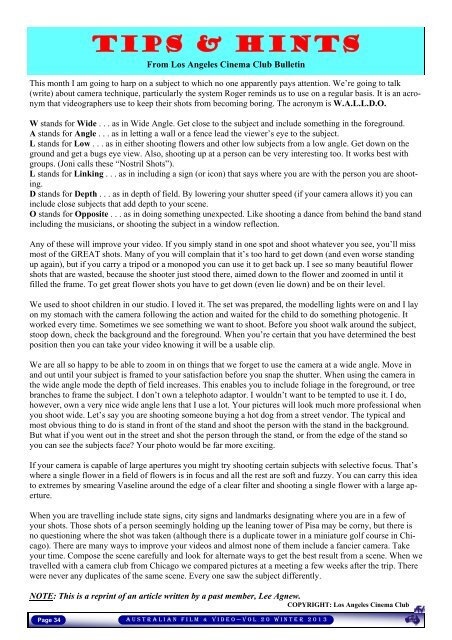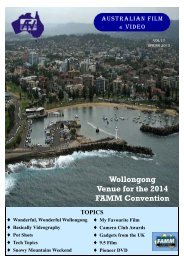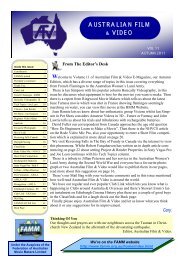20 AFV Winter 2013.pub - Federation of Australian Movie Makers
20 AFV Winter 2013.pub - Federation of Australian Movie Makers
20 AFV Winter 2013.pub - Federation of Australian Movie Makers
You also want an ePaper? Increase the reach of your titles
YUMPU automatically turns print PDFs into web optimized ePapers that Google loves.
TIPS & HINTSFrom Los Angeles Cinema Club BulletinThis month I am going to harp on a subject to which no one apparently pays attention. We’re going to talk(write) about camera technique, particularly the system Roger reminds us to use on a regular basis. It is an acronymthat videographers use to keep their shots from becoming boring. The acronym is W.A.L.L.D.O.W stands for Wide . . . as in Wide Angle. Get close to the subject and include something in the foreground.A stands for Angle . . . as in letting a wall or a fence lead the viewer’s eye to the subject.L stands for Low . . . as in either shooting flowers and other low subjects from a low angle. Get down on theground and get a bugs eye view. Also, shooting up at a person can be very interesting too. It works best withgroups. (Joni calls these “Nostril Shots”).L stands for Linking . . . as in including a sign (or icon) that says where you are with the person you are shooting.D stands for Depth . . . as in depth <strong>of</strong> field. By lowering your shutter speed (if your camera allows it) you caninclude close subjects that add depth to your scene.O stands for Opposite . . . as in doing something unexpected. Like shooting a dance from behind the band standincluding the musicians, or shooting the subject in a window reflection.Any <strong>of</strong> these will improve your video. If you simply stand in one spot and shoot whatever you see, you’ll missmost <strong>of</strong> the GREAT shots. Many <strong>of</strong> you will complain that it’s too hard to get down (and even worse standingup again), but if you carry a tripod or a monopod you can use it to get back up. I see so many beautiful flowershots that are wasted, because the shooter just stood there, aimed down to the flower and zoomed in until itfilled the frame. To get great flower shots you have to get down (even lie down) and be on their level.We used to shoot children in our studio. I loved it. The set was prepared, the modelling lights were on and I layon my stomach with the camera following the action and waited for the child to do something photogenic. Itworked every time. Sometimes we see something we want to shoot. Before you shoot walk around the subject,stoop down, check the background and the foreground. When you’re certain that you have determined the bestposition then you can take your video knowing it will be a usable clip.We are all so happy to be able to zoom in on things that we forget to use the camera at a wide angle. Move inand out until your subject is framed to your satisfaction before you snap the shutter. When using the camera inthe wide angle mode the depth <strong>of</strong> field increases. This enables you to include foliage in the foreground, or treebranches to frame the subject. I don’t own a telephoto adaptor. I wouldn’t want to be tempted to use it. I do,however, own a very nice wide angle lens that I use a lot. Your pictures will look much more pr<strong>of</strong>essional whenyou shoot wide. Let’s say you are shooting someone buying a hot dog from a street vendor. The typical andmost obvious thing to do is stand in front <strong>of</strong> the stand and shoot the person with the stand in the background.But what if you went out in the street and shot the person through the stand, or from the edge <strong>of</strong> the stand soyou can see the subjects face? Your photo would be far more exciting.If your camera is capable <strong>of</strong> large apertures you might try shooting certain subjects with selective focus. That’swhere a single flower in a field <strong>of</strong> flowers is in focus and all the rest are s<strong>of</strong>t and fuzzy. You can carry this ideato extremes by smearing Vaseline around the edge <strong>of</strong> a clear filter and shooting a single flower with a large aperture.When you are travelling include state signs, city signs and landmarks designating where you are in a few <strong>of</strong>your shots. Those shots <strong>of</strong> a person seemingly holding up the leaning tower <strong>of</strong> Pisa may be corny, but there isno questioning where the shot was taken (although there is a duplicate tower in a miniature golf course in Chicago).There are many ways to improve your videos and almost none <strong>of</strong> them include a fancier camera. Takeyour time. Compose the scene carefully and look for alternate ways to get the best result from a scene. When wetravelled with a camera club from Chicago we compared pictures at a meeting a few weeks after the trip. Therewere never any duplicates <strong>of</strong> the same scene. Every one saw the subject differently.NOTE: This is a reprint <strong>of</strong> an article written by a past member, Lee Agnew.COPYRIGHT: Los Angeles Cinema ClubPage 34 AUSTRALIAN FILM & VIDEO—VOL <strong>20</strong> WINTER <strong>20</strong>13










